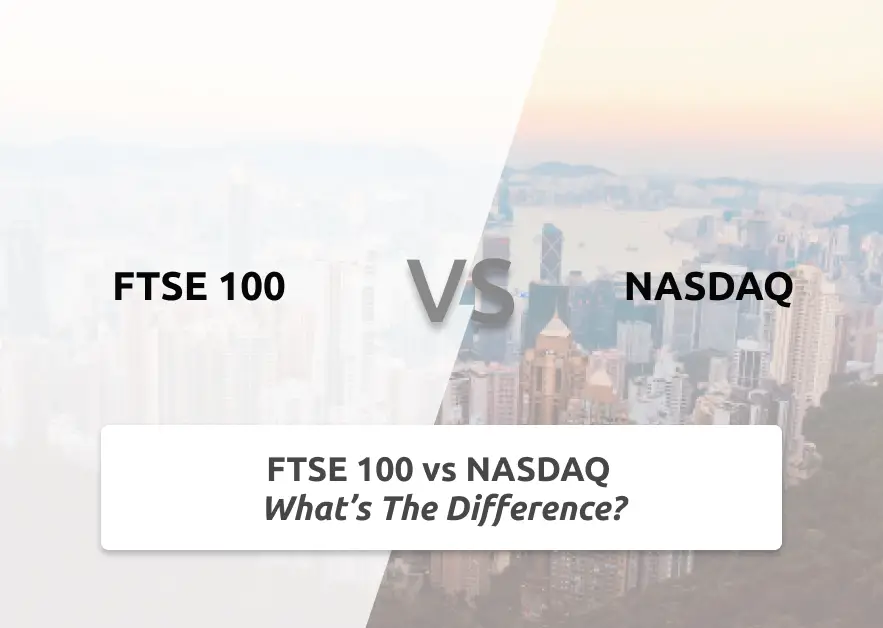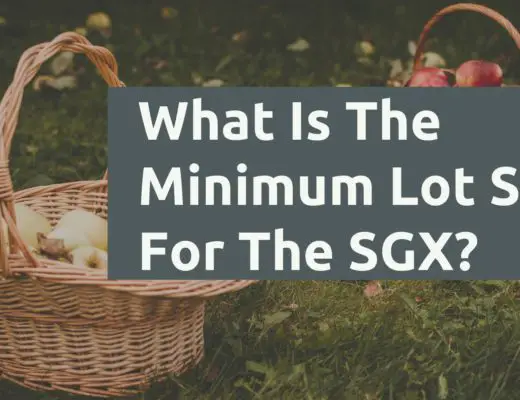Last updated on March 5th, 2022
You may have heard the terms FTSE 100 and the NASDAQ being used in different financial settings, but are still unclear about the difference between these two indices.
FTSE 100 and NASDAQ are both popular indices used to monitor the performance of stocks. However, there are many critical differences between them, and understanding them is the key to knowing which index is right for you.
This guide will help you understand what each of these terms means.
Contents
The difference between FTSE 100 and NASDAQ
Two of the most popular indices for measuring stock market performance are FTSE 100 and NASDAQ. The difference between these two indices lies in their geographical location of origin and the number of stocks included.
The FTSE 100 is the leading share index in the UK. It is a comprehensive list of the top 100 largest companies listed on the London Stock Exchange. These companies are ranked by their market capitalisation.
Market capitalisation refers to the total dollar market value of a company’s outstanding shares of stock. This figure is used to determine a company’s size as opposed to its total assets and is calculated by multiplying the total number of a company’s outstanding shares by the current market price of one share.
Investopedia
Similarly, the NASDAQ is one of the most widely followed stock indexes in the US. Unlike FTSE 100, which is home to various companies in different sectors, the NASDAQ is predominantly tech-focused. As such, many of the world’s most well-known technology companies are listed on the NASDAQ, including Apple, Microsoft, Amazon, and Facebook.
Here is an in-depth comparison to help you understand these two indices better.
Country Diversification
Diversification is a vital component of any investment strategy. It allows you to spread your risk and reduce volatility by investing in multiple assets, meaning that if one asset suffers a downturn, you aren’t exposed to a total loss. This can be achieved by investing in different stocks or sectors and various countries.
As such, FTSE 100 comprises UK companies, while the NASDAQ has 3,000 tech-focused securities based primarily from the US. This is important to know because investing in a single market like the FTSE 100 will expose your portfolio to more risks than if you invest globally or at least in two different markets, e.g. in the NASDAQ.
Type of Stocks
The FTSE 100 is a list of the 100 largest companies that trade on the London Stock Exchange. The stocks included in this index are primarily from the UK.
Only the top 10 stocks in this index are large-cap, with the rest of the other stocks falling in the definition of mid and small-cap stocks.
The NASDAQ is different because it measures all NASDAQ domestic and international-based common type stocks listed on The NASDAQ Stock Market.
Over 3,000 stocks are listed on NASDAQ. The majority of the stocks are large-cap due to giant tech companies like Apple, Facebook and Microsoft on this index.
Top Sectors
Here is a comparison between the top sectors found in the FTSE 100 and NASDAQ as of 18th February 2022.
| FTSE 100 | NASDAQ |
|---|---|
| Consumer Staples 17.9% | Technology 56.0% |
| Financials 17.8% | Consumer Services 21.9% |
| Materials 13.4% | Consumer Goods 9.1% |
| Industrials 12.2% | Healthcare 6.0% |
| Health Care 11.7% | Industrials 4.9% |
As you can see, the FTSE 100 is more focused on consumer staples and financial services, with each of those sectors representing about 18% of its market cap. There are also strong representations from other sectors, including Materials, Industrials, and Healthcare.
On the other hand, NASDAQ has a more extensive representation from the Technology sector, with 56% of its market cap in this industry.
As discussed earlier, NASDAQ has a higher proportion of technology companies than most other exchanges, with Facebook, Apple, and Amazon among its most extensive stocks.
You may also notice that healthcare is a top holding for the FTSE 100. Healthcare is a strong industry and will always be relevant. This is because healthcare provision will always be in demand as long as people require medical attention.
Overall, these two indices have a large proportion in sectors like tech, healthcare, and consumer goods, which have plenty of room to grow.
Top Holdings
The holdings represented within these two indices are very different, as you might expect since they are based around different economies.
The table below illustrates this point:
| FTSE 100 | NASDAQ |
|---|---|
| HSBC Holdings 8.0% | Apple Inc 10.9% |
| Vodafone Group 5.8% | Microsoft Corp 9.7% |
| BP 5.5% | Amazon Inc 8.2% |
| Royal Dutch Shell A 5.0% | Facebook Inc 4.0% |
| British American Tobacco 4.1% | Alphabet Inc 3.9% |
The top 5 holdings of NASDAQ are some of the biggest tech companies in the world including Apple and Microsoft, except for Amazon which is in the consumer service sector.
The top 5 holdings of the FTSE 100 are a little more diversified. Their top holdings are spread across four different sectors:
| Company | Industry |
|---|---|
| HSBC Holdings | Financial |
| Vodafone Group | Communication Services |
| BP | Energy |
| Royal Dutch Shell | Energy |
| British American Tobacco | Consumer Staples |
From this data, the FTSE 100 may have better diversification in terms of the variety of sectors it covers. However, since it only has 100 constituents, it’s a more concentrated index.
On the other hand, NASDAQ may be more tech-focused, but it has over 3,300 company listings that provide more diversity for investors.
Performance
5-year performance of the FTSE 100
5 year performance of NASDAQ
Overall, when you look at the performance of the NASDAQ and the FTSE 100 over the past five years, it is not hard to see where the opportunity lies for investors.
The NASDAQ has shown far more significant growth than the FTSE 100 over this period, and if you were to purchase both indices five years ago, you would be up 155% for NASDAQ (almost triple your initial investment).
The FTSE 100, on the other hand, would have only returned 3.46%.
To add to this, if we look at their growth curves, NASDAQ has constantly been growing higher highs every year, even since 2018. The FTSE 100 has not hit its all-time high but is slowly climbing back to it since its decline in 2018.
So there we have it; NASDAQ has been crushing the FTSE 100 since 2017 – even with the significant dip in 2008!
Verdict
Here is a comparison between the FTSE 100 and NASDAQ:
| FTSE 100 | NASDAQ | |
|---|---|---|
| Type of Stocks | Large and mid-cap UK equities | Large-cap US equities |
| Number of Holdings | 100 | 3,300 |
| Top Sectors | Consumer Staples 17.9% Financials 17.8% Materials 13.4% Industrials 12.2% Health Care 11.7% | Technology 56.0% Consumer Services 21.9% Consumer Goods 9.1% Healthcare 6.0% Industrials 4.9% |
| Top Holdings | HSBC Holdings 8.0% Vodafone Group 5.8% BP 5.5% Royal Dutch Shell A 5.0% British American Tobacco 4.1% | Apple Inc 10.9% Microsoft Corp 9.7% Amazon Inc 8.2% Facebook Inc 4.0% Alphabet Inc 3.9% |
| Exposure to Global Economy | Weaker | Greater |
| Past Performance | Weaker | Stronger |
Conclusion
Both the FTSE 100 and the NASDAQ are good places to invest your money, but for different reasons.
If you’re looking at long-term investments in reliable companies from the UK, then the FTSE may be a better choice.
However, if you just want to invest in big technology companies from the US in general, there are plenty of NASDAQ stocks that may work better for you.

Do you like the content on this blog?
To receive the latest updates, you can follow us on our Telegram channels (Personal Finance or Crypto) and Facebook.
Are you passionate about personal finance and want to earn some flexible income?





